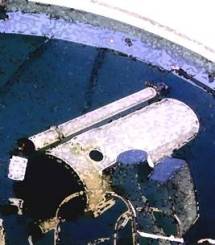What’s GEMSS all about? Monday, 5 February 2007
Posted by pauldavid in General Exoplanet.trackback
Since 2003, and more broadly since the summer of 2006, this has been our our Target, your garden-variety (but relatively higher-metal, and low on flaring) Red Dwarf, about one-third or so the size of our own Sun. To get a quick 411 about red dwarfs (which are small, relatively cool stars and while populous, are pretty dim in terms of their relative magnitude), look here. OK – actually, the real targets are the Exoplanets that [might] orbit about such a red (or M) Dwarf… There are indications that red dwarfs could harbor earth-massed terrestrial planets… we discussed this potential in a paper we recently published in Astrophysical Journal (and you can also find a preprint here, and a blog about it here). Check out the Overview Tab to get more info on our project parametrics….
At The Naval Observatory, I / we are using a 24-inch aperture f/15 classic Cassegrain to do the job, a la:
We are partnering with colleagues at James Cook University (David Blank, using Perth Observatory), and other places (such as TransitSearch with Greg Laughlin, at UC Santa Cruz/Lick Observatory), to operate a continuous-coverage web of small telescopes — to characterize our prolific red Dwarf population’s propensity to have transiting exoplanets… We have often used Todd Henry’s RECONS list of nearby stars, too – his list is quite interesting and becomes a partial basis for our “search” portion (as opposed to an un-biased ‘survey portion’ where we fill in, later).
We like having observers girding the Earth in longitude, as we’d like to keep a continuous eye on our selected targets so potential detections don’t escape us — or equally important, we can convincingly say no transits took place.
We’ve also had students from USNA and Yale work at USNO on the project in its enfancy; another is expected this summer to carry on the torch. Greg blogs about our M dwarf harbinger-of-terrestrials ideas in a more technical fashion here and here, on his excellent Oklo website, home of Systemic.
So… a ‘Transit” you say? Well, a transit is basically this (of HD 209458, with credit to TEP, who also sought transits through 2001):
We look for these transits using a differential (specifically aperture) photometry technique (we use AIP4WIN and sometimes CCDSoft) which is pretty straightforward in principle, but demands alot of discipline, patience and practice to do it well enough to see the flux dips (as the planet crosses the star — and if the the geometry is ‘right’). Fortunately in our study, the dips we seek offset the overall faintness problems, with them typically being a more generous ~10% in variation (tenfold brighter than if the planet orbited a sun-sized star).
Subsequent data reduction consists of assembling the filtered images from the CCDs and subtracting noise (here called Darks and Flats; though at USNO our USNA-sponsored cryogenic CCD system allows us to skip darks in the initial images), and then sequencing the target star intensities to discern lightcurves, starting with collection and processing software, error analysis methods, and plotting work. Here are two advanced amateurs’ experences with the process, here and here. AAVSO also deals in photometry, and give a good practical accounting, here, here and here. When doing a large sample of curves, such as in our Survey mode in GEMSS, looking for a periodicity in such curves (a periodicity infers orbital motion) is really important to getting the job done… So we have work initiated on devising s PHP-interfaced (and MATLAB and / or Mathcad-derived) program which “folds” the data in a sort-of overlay-match-up, curve-fitting scheme to look for and predict such repetitions that might infer orbits.
We began this project last summer, primarily at USNO in Washington, DC. Shortly we’ll begin expanding toward continuous operations alongside JCU/Perth — and thereafter, we expect to expand further. See our Collaboration Tab for details…
More soon!



Earth Satelite
I couldn’t understand some parts of this article, but it sounds interesting